Donatella Darsena
Design of stacked intelligent metasurfaces with reconfigurable amplitude and phase for multiuser downlink beamforming
Aug 29, 2024Abstract:A novel technology based on stacked intelligent metasurfaces (SIM) has recently emerged. This platform involves cascading multiple metasurfaces, each acting as a digitally programmable physical layer within a diffractive neural network. SIM enable the implementation of signal-processing transformations directly in the electromagnetic wave domain, eliminating the need for expensive, high-precision, and power-intensive digital platforms. However, existing studies employing SIM in wireless communication applications rely solely on nearly passive structures that control only the phase of the meta-atoms in each layer. In this study, we propose a SIM-aided downlink multiuser transmission scheme, where the SIM at the base station (BS) end is designed by combining nearly passive layers with phase-only reconfiguration capabilities and active layers integrated with amplifier chips to enable amplitude control. Our optimal design aims at maximizing the sum rate for the best group of users by jointly optimizing the transmit power allocation at the BS and the wave-based beamforming at the SIM. In addition to the standard sum-power constraint at the BS, our optimization framework includes two additional constraints: (i) a per-stream power preserving constraint to prevent propagation losses across the SIM, and (ii) an amplitude constraint to account for power limitations for each active layer. To further reduce the complexity of the optimal beamforming solution, we explore a simple yet suboptimal zero-forcing (ZF) beamforming design, where the wavebased transformation implemented by the SIM is selected to eliminate interference among user streams. Finally, extensive Monte Carlo simulations demonstrate that incorporating both nearly passive and active layers within the SIM significantly enhances capacity compared to previously reported phase-only coding SIM.
CycloDSP: A cyclostationary signal analysis tool for GNU Radio
May 27, 2024Abstract:In this paper, we present a first attempt to incorporate in the GNU Radio ecosystem a tool called CycloDSP, devoted to the analysis of complex-valued cyclostationary signals. Such signals are ubiquitous in communication and signal processing, exhibiting periodic or almost periodic statistics that are characterized by a countable set of cycle frequencies, which are related to the main signal periodicities. Common cycle frequencies for modulated signals are multiple of the baudrate and/or combination of the carrier frequency and baudrate. Conventional estimation strategies for cyclostationary signal analysis typically exhibit a high computational burden. Many approaches aimed at reducing complexity exploit fast Fourier transform (FFT) algorithms, which are very efficient for batch data but are not suited for continuously streaming data, typically encountered in software-defined radio (SDR) applications. The aim of this paper is to develop an out-of-tree (OOT) GNU Radio module containing a set of building block functions, aimed at estimating functions, such as the cyclic correlation functions, typically employed for cyclostationary signal analysis. The proposed implementation must be designed so as to ensure high efficiency in processing continuous data streams of complex samples, both in terms of computational load and data storage, in order to be executed on general purpose computers. We tested our implementation by estimating in real-time the second-order cyclic statistics of a Gaussian minimum-shift keying (GMSK) modulated signal, which belongs to a class of signals commonly employed in aeronautical telemetry datalinks.
A Hybrid NOMA-OMA Scheme for Inter-plane Intersatellite Communications in Massive LEO Constellations
Jul 17, 2023Abstract:Communication between satellites in low-Earth orbit (LEO) constellations takes place through intersatellite links (ISLs). Unlike intra-plane ISLs, which interconnect satellites belonging to the same orbital plane with fixed relative distance, inter-plane ISLs experience significant Doppler frequency shifts, since satellites belonging to different orbital planes exhibit time-varying relative distance (required, e.g., to minimize the risk of physical collisions between satellites). In this paper, we consider the problem of connecting multiple satellites, belonging a massive LEO Walker Delta constellation, to a receiving satellite, referred to as the sink. Specifically, we consider a hybrid multiple access scheme, which employs a combination of non-orthogonal multiple access (NOMA), where ISLs share the same time-frequency resource blocks, and orthogonal multiple access (OMA), where ISLs employs orthogonal resource blocks. To this aim, the set of satellites transmitting towards the sink is divided into groups, where NOMA is employed within each group, whereas OMA is used to separate different groups. Such a scheme subsumes as special cases both pure-OMA and pure-NOMA. Our study highlights that similar Doppler frequency shifts have a large impact on the individual rates of the satellites in a pure-NOMA scheme, thus reducing the network fairness of this technique. Motivated by such a fact, we develop design strategies of the proposed hybrid NOMA-OMA scheme, which exploit inter-plane Doppler frequency diversity to enhance fairness among the satellites, while ensuring a significantly higher sum-rate capacity compared to the pure-OMA technique. Numerical results corroborate our theoretical analysis, by demonstrating both the fairness enhancement of the proposed techniques over the pure-NOMA scheme, as well as their capacity improvement over the pure-OMA one.
On the capacity of TDMA downlink with a reconfigurable intelligent surface
May 22, 2023Abstract:We provide accurate approximations of the sum-rate capacity of a time-division multiple access (TDMA) down-link, when a reconfigurable intelligent surface (RIS) assists the transmission from a single-antenna base station (BS) to K single-antenna user equipments (UEs). We consider the fading effects of both the direct (i.e., BS-to-UEs) and reflection (i.e, BS-to-RIS-to-UEs) links, by developing two approximations: the former one is based on hardening of the reflection channel for large values of the number Q of meta-atoms at the RIS; the latter one relies on the distribution of the sum of Nakagami variates and does not require channel hardening. Our derivations show the dependence of the sum-rate capacity as a function of both K and Q, as well as to establish a comparison with a TDMA downlink without an RIS. Numerical results corroborate the accuracy of the proposed approximations and the validity of the mathematical analysis.
Space-time reconfigurable intelligent surfaces for downlink multiuser transmissions
Apr 24, 2023Abstract:Amplitude, phase, frequency, and polarization states of electromagnetic (EM) waves can be dynamically manipulated by means of artificially engineered planar materials, composed of sub-wavelength meta-atoms, which are typically referred to as metasurfaces. Until now, researchers in wireless communications have mainly focused their attention on space-domain designs of reconfigurable intelligent surfaces (RISs), where the main concern is to engineer the spatial-phase gradient across the RIS to decouple incidence and reflected/refracted directions. However, such designs do not exploit the temporal dimension. Indeed, additional degrees of freedom for controlling EM waves can be gained by applying a time modulation to the reflection response of the metasurface, thereby attaining the so-called space-time RISs. We develop a general framework where a downlink multiuser transmission over single-input single-output slow fading channels is assisted by a digitally controlled space-time RIS. The conclusions of our analysis in terms of system design guidelines are as follows: (i) if the network utility function is the sum-rate time-averaged network capacity, without any constraint on fair resource allocation, and full CSIT is available, then a temporal modulation of the electronic properties of the RIS is unnecessary; (ii) if partial CSIT is assumed only, a random modulation in both time and space of the reflection coefficients of the RIS meta-atoms allows to achieve a suitable balance between sum-rate time-averaged capacity and user fairness, especially for a sufficiently large number of users; (iii) regardless of the available amount of CSIT, the design of temporal variations across the RIS is instrumental for developing scheduling algorithms aimed at maximizing the network capacity subject to some fairness constraints.
Anti-jamming beam alignment in millimeter-wave MIMO systems
Oct 15, 2021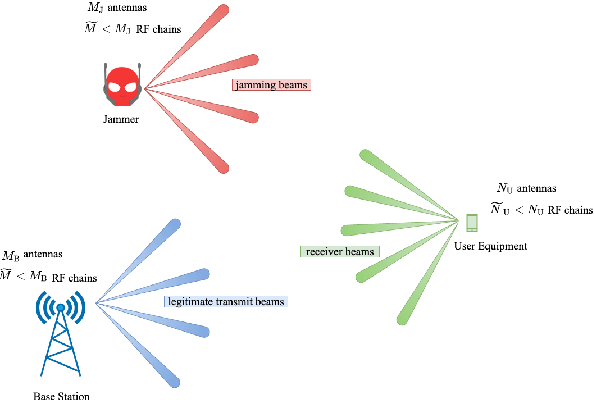



Abstract:In millimeter-wave (MMW) multiple-input multiple-output (MIMO) communications, users and their corresponding base station (BS) have to align their beam during both initial access and data transmissions to compensate for the high propagation loss. The beam alignment (BA) procedure specified for 5th Generation (5G) New Radio (NR) has been designed to be fast and precise in the presence of non-malicious interference and noise. A smart jammer might exploit this weakness and may launch an attack during the BA phase in order to degrade the accuracy of beam selection and, thus, adversely impacting the end-to-end performance and quality-of-service experienced by the users. In this paper, we study the effects of a jamming attack at MMW frequencies during the BA procedure used to perform initial access for idle users and adaptation/recovery for connected users. We show that the BA procedure adopted in 5G NR is extremely vulnerable to a smart jamming attack and, consequently, we propose a countermeasure based on the idea of randomized probing, which consists of randomly corrupting the probing sequence transmitted by the BS in order to reject the jamming signal at the UE via a subspace-based technique based on orthogonal projections and jamming cancellation. Numerical results corroborate our theoretical findings and show the very satisfactory accuracy of the proposed anti-jamming approach.
Reception strategies for sky-ground uplink non-orthogonal multiple access
Aug 15, 2021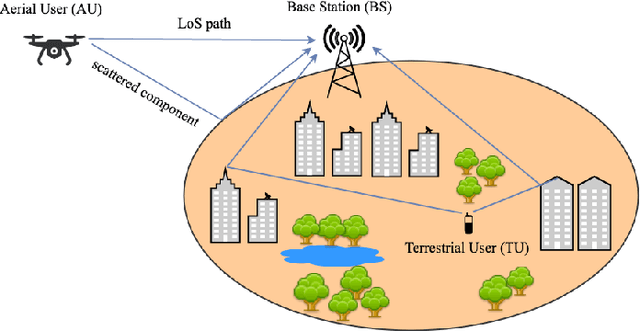
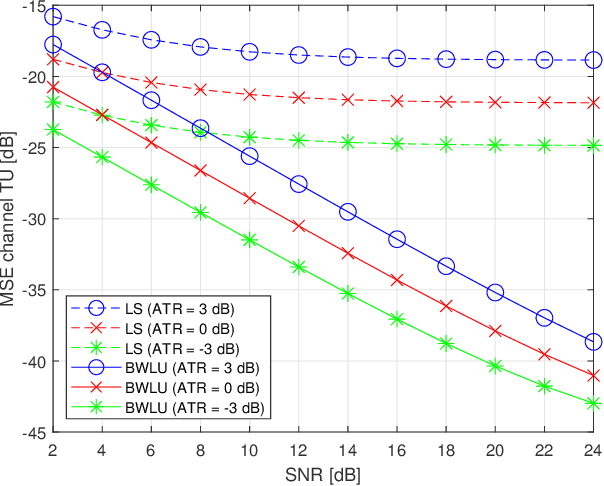

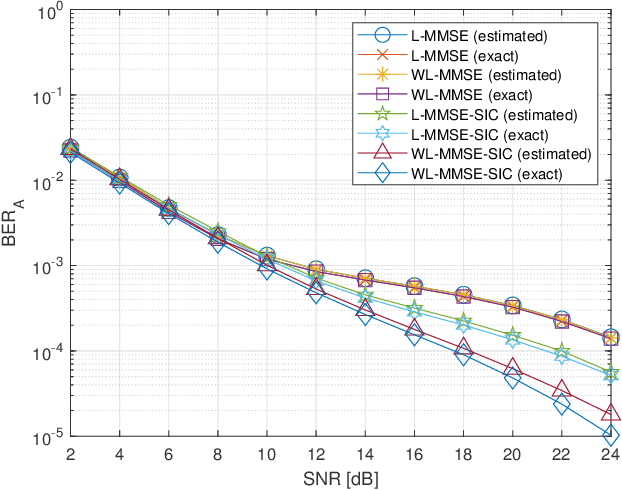
Abstract:Integration of unmanned aerial vehicles (UAVs) into fifth generation (5G) and beyond 5G (B5G) cellular networks is an intriguing problem that has recently tackled a lot of interest in both academia and industry. An effective solution is represented by cellular-connected UAVs, where traditional terrestrial users coexist with flying UAVs acting as additional aerial users, which access the 5G/B5G cellular network infrastructure from the sky. In this scenario, we study the challenging application in which an UAV acting as aerial user (AU) and a static (i.e., fixed) terrestrial user (TU) are paired to simultaneously transmit their uplink signals to a ground base station (BS) in the same time-frequency resource blocks. In such a case, due to the highly dynamic nature of the UAV, the signal transmitted by the AU experiences both time dispersion due to multipath propagation effects and frequency dispersion caused by Doppler shifts. On the other hand, for a static ground network, frequency dispersion of the signal transmitted by TU is negligible and only multipath effects have to be taken into account. To decode the superposed signals at the BS by using finite-length data record, we propose a novel sky-ground (SG) nonorthogonal multiple access (NOMA) receiving structure that additionally exploits the different circularity/noncircularity and almost-cyclostationarity properties of the AU and TU by means of improved channel estimation and time-varying successive interference cancellation. Numerical results demonstrate the usefulness of the proposed SG uplink NOMA reception scheme in future 5G/B5G networks.
Detection and blind channel estimation for UAV-aided wireless sensor networks in smart cities under mobile jamming attack
May 25, 2021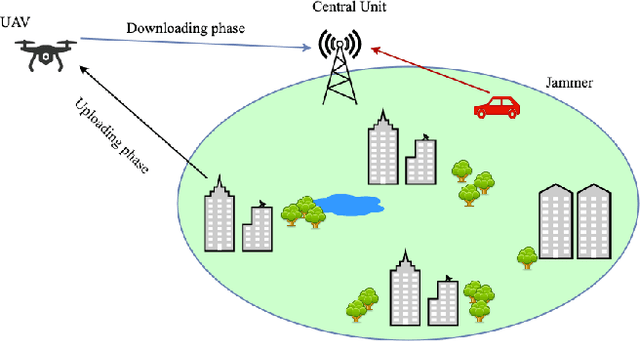
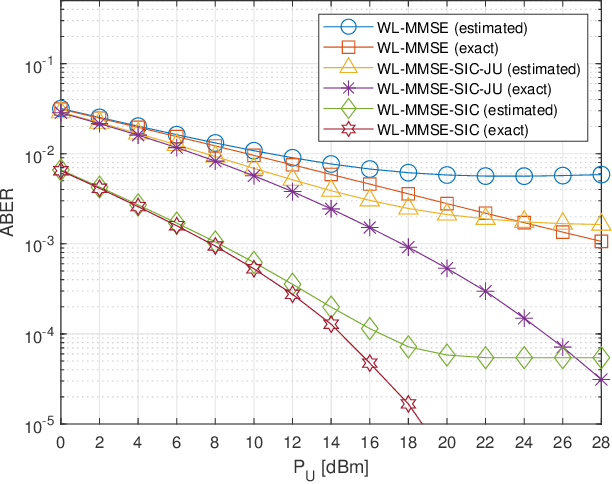
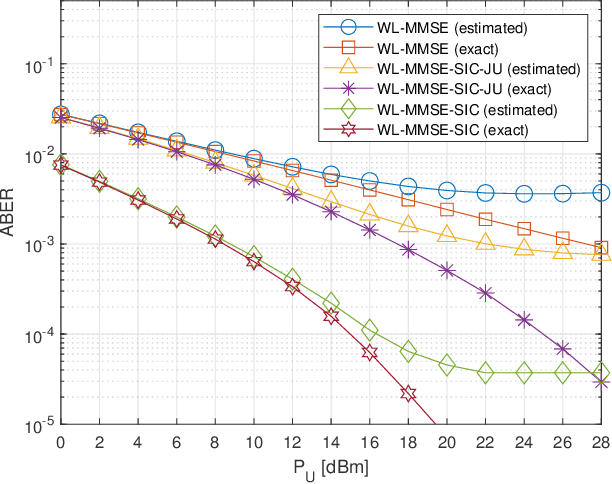
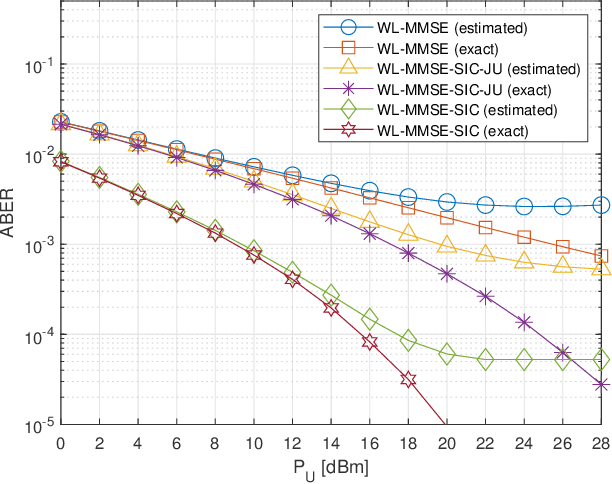
Abstract:There exist several ways of integrating unmanned aerial vehicles (UAVs) into wireless sensor networks (WSNs) for smart city applications. Among the others, a UAV can be employed as a relay in a "store-carry and forward" fashion by uploading data from ground sensors and meters and, then, downloading it to a central unit. However, both the uploading and downloading phases can be prone to potential threats and attacks. As a legacy from traditional wireless networks, the jamming attack is still one of the major and serious threats to UAV-aided communications, especially when the jammer is mobile, too, e.g., it is mounted on an UAV or inside a terrestrial vehicle. In this paper, we investigate anti-jamming communications in UAV-aided WSNs operating over doubly-selective channels. In such a scenario, the signals transmitted by the legitimate transmitters (sensors and meters in the uploading phase or the UAV in the downloading phase) and the malicious mobile jammer undergo both time dispersion due to multipath propagation effects and frequency dispersion caused by Doppler shifts. To suppress the jamming signal, we propose a blind physical-layer technique that jointly exploits amplitudes, phases, time delays, and Doppler shifts differences between the two superimposed signals. Such parameters are estimated from data through the use of algorithms exploiting the almost-cyclostationarity properties of the received signal. Simulation results corroborate the antijamming capabilities of the proposed method, for different mobility scenario of the jammer.
 Add to Chrome
Add to Chrome Add to Firefox
Add to Firefox Add to Edge
Add to Edge